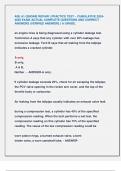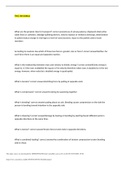ASE A1 (ENGINE REPAIR ) PRACTICE TEST – CUMULATIVE 2024-
2025 EXAM |ACTUAL COMPLETE QUESTIONS AND CORRECT
ANSWERS (VERIFIED ANSWERS ) A GRADE.
an engine miss is being diagnosed using a cylinder leakage test.
Technician A says that any cylinder with over 20% leakage has
excessive leakage. Tech B says that air leaking from the tailpipe
indicates a cracked cylinder.
A only,
B only,
A & B,
Neither . - ANSWER-A only:
If cylinder leakage exceeds 20%, check for air escaping the tailpipe,
the PCV valve opening in the rocker arm cover, and the top of the
throttle body or carburetor.
Air leaking from the tailpipe usually indicates an exhaust valve leak
during a compression test, a cylinder has 40% of the specified
compression reading. When the tech performs a wet test, the
compression reading on this cylinder has 75% of the specified
reading. The cause of the low compression reading could be
worn piston rings, a burned exhaust valve, a bent
intake valve, a worn camshaft lobe, - ANSWER-
,worn piston rings if compression increases during
a wet test, this indicates worn piston rings.
Compression would not increase if an exhaust
valve is burned, intake valve is bent, or camshaft
lobe is worn.
the customer complains that the engine cranks but does not start; the
first thing to check should be
valve train operation, battery voltage,
compression, engine vacuum, - ANSWER-valve
train operation:
if the engine cranks properly, the battery is not the problem.
Compression would not be the FIRST test, and because engine
vacuum is low during a crank, a vacuum test would not be conclusive.
during a cylinder balance test on an engine with fuel injection, one
cylinder provides very little rpm drop.
Tech A says the ignition system may be misfiring on that cylinder.
Tech B says the engine may have an intake manifold vacuum leak.
A only,
B only,
A & B,
Neither , - ANSWER-Both A&B
,Both a misfiring ignition system and an intake manifold leak could
cause a cylinder to contribute too little power
while discussing basic diagnostic procedures,
Tech A says the most complicated diagnostic tests should be
performed first. Tech B says that you should first question the
customer to obtain as much info as possible about the problem
A,
B,
A & B,
Neither, - ANSWER-B
Always attempt the more simple diagnosis first
with the engine idling, a vacuum gauge connected to the intake
manifold fluctuates (from 15 to 20). These fluctuations may be caused
by
late ignition timing, intake manifold vacuum leaks, a restricted
exhaust system, sticky valve stems and guides, - ANSWER-
sticky valve stems and guides
-late ignition timing would result in a low, steady reading
, -intake manifold leaks would cause a very low, steady reading -a
restricted exhaust system would cause vacuum to slowly decrease
after the engine was accelerated and held steady
oil is leaking from the crankshaft rear main bearing seal on an engine.
Tech A says the oil seal could be faulty. Tech B says the PCV system
may not be functioning.
A, B,
A & B,
Neither, - ANSWER-A&B
A high-pitched squealing noise is heard during hard acceleration.
This may be the cause of:
intake manifold leak, the choke stuck closed fuel system leak
small leak in exhaust manifold - ANSWER-small leak in exhaust
manifold
-intake manifold leak causes a high-pitched whistle at idle and low
speeds
-carb choke stuck closed will not cause a high-pitched whistle
-fuel system leak normally would not cause a noise
a heavy thumping noise occurs with the engine idling, but the oil
pressure is normal. this may be caused by:





